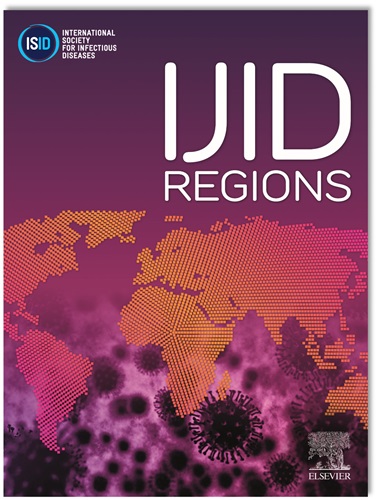喀麦隆三种生态流行病学环境中伊蚊物种的生物组学及其对杀虫剂的敏感性概况
IF 4.8
2区 医学
Q1 INFECTIOUS DISEASES
引用次数: 0
摘要
背景:乙型肝炎病毒在热带/亚热带国家引起严重关注。在喀麦隆,港口城市和被森林包围的城市是登革热和黄热病的主要热点。由于缺乏针对大多数虫媒病毒疾病的有效治疗方法和疫苗,媒介控制仍然是防止进一步复发的最有效措施。迄今为止,对其主要媒介埃及伊蚊和白纹伊蚊在这种环境中的生物学特性知之甚少。本研究旨在评估喀麦隆三个城市这些媒介的生物生态、分布和对杀虫剂的敏感性。方法于2021年9月至2022年10月在贝尔图瓦(稀树草原地区)、克里比(城市港口)和桑梅里马(森林地区)进行了形态学调查。采用深埋法采集未成熟伊蚊,并测定其隐虫指数。在对埃及伊蚊和白纹伊蚊后代进行羽化和形态鉴定后,采用世卫组织生物测定法,利用F0和F1对常用杀虫剂的表型抗性现状进行评估,并根据所测杀虫剂的不同评估死亡率。结果在Sangmelima(41.47%)、Kribi(33.47%)和Bertoua(25.05%)共鉴定出475个孳生点;轮胎和塑料容器最为丰富。共捕获蚊虫2364只,隶属4属9种。1864年记录的伊蚊种包括伊蚊;白纹伊蚊(72%);埃及伊蚊(25.91%)和伊蚊(2.09%)。所有研究地点均存在这些主要病媒。Ae。桑梅里马和克里比以白纹伊蚊为主;埃及伊蚊主要在贝尔图阿被发现。根据室内指数,登革热和黄热病在克里比和贝尔图阿的传播较高。Ae。研究地点的埃及伊蚊对氯菊酯、溴氰菊酯和滴滴涕均有抗药性。克里比和贝尔图阿地区白纹伊蚊对恶虫威有抗药性。但这些物种均对马拉硫磷敏感。研究表明,Ae。白纹伊蚊和伊蚊。埃及伊蚊幼虫生活在各种各样的繁殖地(Ngo等人,2020),这些物种主要分布在全国各地(Tedjou等人,2019)。Ae。白纹伊蚊和埃及伊蚊对有机磷(马拉硫磷)敏感。这些结果与之前的研究相似(Kamgang et al., 2017)。观察到的耐受性和耐药性可能是由于使用杀虫剂,如喷雾剂和提醒剂,这变得越来越普遍(Nchoutpouen等人,2019)。结论鉴于虫媒虫媒病病例的增加,迫切需要实施虫媒病毒媒介监测和控制规划。为了有效控制虫媒病毒,需要有针对性的方法来限制这些媒介在我们环境中的传播。这项工作有助于利用生态和易感性参数控制病媒,目的是预防喀麦隆可能发生的虫媒病毒流行。本文章由计算机程序翻译,如有差异,请以英文原文为准。
Bionomics of Aedes mosquito species in three eco-epidemiological settings of Cameroon and their susceptibilities profiles to insecticides
Background
Arboviruses represent a serious concern in tropical/subtropical countries. In Cameroon, port cities and cities surrounded by forests constitute the main hot-spot of dengue and yellow fever. Due to the absence of effective treatments and vaccines against most arboviruses diseases, vector control remains the most effective measure to prevent further resurgence. To date, little is known about the bionomics of their main vectors Aedes aegypti and Aedes albopictus in such environments. This study aim to assess the bioecology, distribution and susceptibility profiles to insecticides of these vectors in three cities of Cameroon.
Methods
Entomological surveys were undertaken from September 2021 to October 2022 in Bertoua (savanna area), Kribi (city port) and Sangmelima (forested area). Immature stages of Aedes spp. were collected by deeping and Stegomyia indexes were estimated. After emergence and morphological identification, F0 and F1 of Aedes aegypti and Aedes albopictus progeny will be used to assess the current phenotypic resistance status to the commonly used insecticides using WHO bioassays and mortality rates were assess according to the different insecticides tested.
Results
A total 475 breeding sites in Sangmelima (41.47%), Kribi (33.47%) and Bertoua (25.05%) were identified. Tires and plastic containers were most abundant. A total of 2364 mosquitoes belonging to 4 genera and 9 species were collected. Aedes species recorded (1864) included Ae. albopictus (72%), Ae. aegypti (25.91%), and Aedes spp. (2.09%). These main vectors were present in all the study sites. Ae. albopictus was predominant in Sangmelima and Kribi while Ae. aegypti was mostly found in Bertoua. According to house indexes, transmission of dengue and yellow fever were high in Kribi and Bertoua. Ae. aegypti across study sites were found to be resistant to permethrin, deltamethrin and DDT, while Ae. albopictus was resistant to bendiocarb in Kribi and Bertoua. However, all these species were susceptible to malathion.
Discussion
The study shows that Ae. albopictus and Ae. aegypti larvae live in a wide variety of breeding sites (Ngo et al., 2020), those species are largely distributed across the country(Tedjou et al., 2019). Ae. albopictus and Aedes aegypti were sensitive to organophosphates (malathion). These results are similar to previous studies (Kamgang et al., 2017). The tolerance and resistance observed could be due to the use of insecticides such as sprays and reminders, which are becoming more and more common(Nchoutpouen et al., 2019).
Conclusion
The implementation of surveillance and control programmes for arbovirus vectors is urgent required in view of the increase in cases of arboviroses. To control arboviruses effectively, a targeted approach is needed to limit the spread of these vectors in our environment. This work is a contribution to vector control using ecological and susceptibility parameters with the aim of preventing a possible arbovirus epidemic in Cameroon.
求助全文
通过发布文献求助,成功后即可免费获取论文全文。
去求助
来源期刊
CiteScore
18.90
自引率
2.40%
发文量
1020
审稿时长
30 days
期刊介绍:
International Journal of Infectious Diseases (IJID)
Publisher: International Society for Infectious Diseases
Publication Frequency: Monthly
Type: Peer-reviewed, Open Access
Scope:
Publishes original clinical and laboratory-based research.
Reports clinical trials, reviews, and some case reports.
Focuses on epidemiology, clinical diagnosis, treatment, and control of infectious diseases.
Emphasizes diseases common in under-resourced countries.

 求助内容:
求助内容: 应助结果提醒方式:
应助结果提醒方式:


